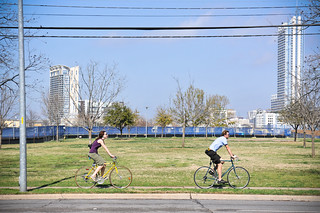A new report Wednesday from U.S. Public Interest Research Group shows, among other things, that there are many ways to look at the same numbers.
Most Americans, including most Portlanders, “still” drive for transportation? True.
The use of cars is on the longest slide ever recorded, one that seems only partly related to economic trends? Equally true.
And as US PIRG’s latest report, Transportation in Transition: A Look at Changing Travel Patterns in America’s Biggest Cities shows, this isn’t just because of the rapid drops in supposedly “weird” enclaves like Portland or Austin. It’s happening almost everywhere. To quote from PIRG:

–Download PDF here–
- The proportion of workers commuting by private vehicle—either alone or in a carpool—declined in 99 out of 100 of America’s most populous urbanized areas between 2000 and the 2007-2011 period averaged in U.S. Census data.
- From 2006 to 2011, the average number of miles driven per resident fell in almost three-quarters of America’s largest urbanized areas for which up-to-date and accurate Federal Highway Administration data are available (54 out of 74 urban areas).
- The proportion of households without cars increased in 84 out of the 100 largest urbanized areas from 2006 to 2011. The proportion of households with two cars or more cars decreased in 86 out of the 100 of these areas during that period.
- The proportion of residents bicycling to work increased in 85 out of 100 of America’s largest urbanized areas between 2000 and 2007-2011.
- The number of passenger-miles traveled per capita on transit increased in 60 out of 98 of America’s large urbanized areas whose trends could be analyzed between 2005 and 2010.
This is the latest in a series of reports by US PIRG, a left-leaning legal/research/advocacy group, that have drawn on federal data to highlight a trend that relatively few people had noticed: just about every available indicator is showing that (as the cliche now goes) the country’s “love affair with the automobile” seems to be ending.
“Instead of wasting taxpayer dollars continuing to enlarge our grandfather’s Interstate Highway System, we should invest in the kinds of transportation options that the public increasingly favors.”
— Phineas Baxendall, USPIRG
“Instead of wasting taxpayer dollars continuing to enlarge our grandfather’s Interstate Highway System, we should invest in the kinds of transportation options that the public increasingly favors,” researcher Phineas Baxendall wrote.
The typical response to this claim has been that the weak economy has been throwing off the numbers. But the trend started in 2004, four years before the last recession hit, and the trend has continued even as the U.S. economy has been recovering.
Today’s report, which analyzies the driving decline at the metro-area level, finds further evidence: This decline of driving is no bigger in hard-hit cities like Miami or Tucson than it has been in resilient cities like Pittsburgh or New Orleans.
Here in the Portland area, we were hurt moderately by the recession, ranking 30th of 74 metro areas in increased unemployment from 2006 to 2011. And the decline in our driving over that period was slightly faster than average (we rank 24th of 74).
The Oregonian’s story last month was completely correct that 71 percent of Portland-area workers drive alone. And (as a BikePortland reader mentioned to me recently) it’s just as true that 99 percent of adults pay rent, mortgage, etc., for the places they live. But that doesn’t mean they want to. Today’s report is the latest sign that, increasingly, Americans (Portlanders and otherwise) want other things more than another hour behind the wheel.


